![]()
![]()
![]()
Use LEFT and RIGHT arrow keys to navigate between flashcards;
Use UP and DOWN arrow keys to flip the card;
H to show hint;
A reads text to speech;
199 Cards in this Set
- Front
- Back
|
S phase
|
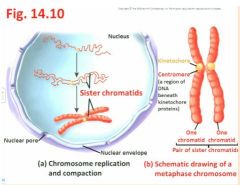
- S is the time for Synthesis (=replication) of the nuclear DNA; each elongated chromosome has been duplicated, and is now said to consist of sister chromatids - see Fig. 14.10
"the bulk of what we're seeing here may be 23-24 hours so interphase is a long phase" didn't you say that 20 hours for cell division was fast ealrier somewhere? - For now, the sister chromatids remain attached at their centromeres, a region of DNA beneath kinetochore proteins which are the eventual attachment points of part of the spindle apparatus - see Fig 14.10a, b "hard to identify chromatin starts to condense so we can more easily see it "now you have each sister chromatid which will eventually say goodbye but for now is hooked up at the centromere… kinetochore" |
|
|
When S phase is completed...?
|
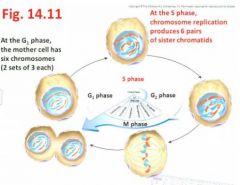
- When S phase is completed, the cell then contains twice as many chromatids as the number of chromosomes present in the G1 phase - revisit fig 14.11,
|
|
|
cell division table?
|
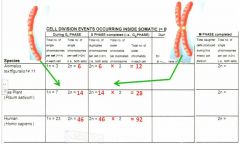
|
|
|
members of a pair of chromosomes?
|
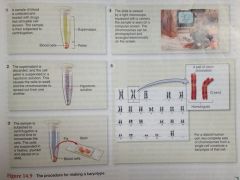
- Note that members of a pair of chromosomes are called homologues (one homologue received from mother, the other from father) - see Fig 14.9 (female, human karyotype)
"down in the bottom, this is the 23rd chromosome and there is no Y, and we have diff steps of that process… we can go back to a few lessons ago where we were talking about hypotonic solutions so water rushes in to make it more plump and in that case this helps to separate the chromosomes so they're more easily spread out and then by microscopy after fixation, in the top right in the monitor you can see all manner of chromosomes and those can be imaged and then cut and pasted and lined up in this way and so that is what a karyotype is and so there you can see the 23 types of chromosomes " |
|
|
closer look at karyotype picture?
|
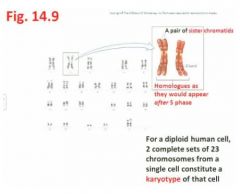
"...we know this is a human cell and we have two complete sets of 23 chromosomes from a single cell and that constitutes the karyotype of that particular cell; here we have separate chromosomes but that chromosome has undergone the S phase and so going into the G phase, that is what it would look like with it's pairs of chromatids and then the same has happened say from the other parents, homologous chromosome number 2."
|
|
|
G2 phase
|
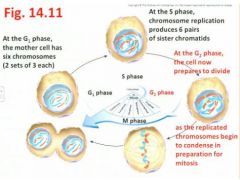
- the second Gap (gap before you get to the M phase) or Growth stage where the cell prepares for division, eventually to be followed by the M phase - revisit Fig 14.11"Sister chromatids per chromosome are going to start to condense and coil a little more so it's easier to see them as chromosomes in the nucleus which is about to start breaking up"
|
|
|
M phase
|

- includes both Mitosis and Cytokinesis (we'll see this soon) [Note: G0 phase - assigned to certain cells that have simply postponed a commitment to a further cell division, or have differentiated to a mature state (eg ,nerve cells in animals) and so will never divide again]
- Duration of the cell cycle varies tremendously, from several minutes (eg embryos) to several months (eg slow-growing cells of adults) - As an example, in actively dividing cells of an adult mammal, it takes 24 hours to complete a cell cycle, with these intervals being typical: - G1 phase (11 hrs), S phase (8 hrs), G2 phase (4hrs) M phase (1hr) - Thus even though its duration is relatively very short, there are several noteworthy details pertaining to the M phase … revisit Fig 4.11 |
|
|
Mitosis and Cytokinesis (chapter 14 , pp. 322-327)
|
- The M phase of the cell cycle includes 2 consecutive processes:
1) Mitosis results in the orchestrated division of the genetic material (DNA) of the mother cell`s nucleus, to deliver the same complement (i.e.. number and type) of chromosomes into the two genetically identical daughter nuclei; followed by 2) Cytokinesis in which the mother cell`s cytoplasm is separated into the two daughter cells (we`ll return to cytokinesis shortly) Mitosis involves four progressive steps (prophase, metaphase, anaphase, telophase) of chromosome sorting and separation - |
|
|
Prophase
|
- the elongated chromosomes duplicated during S phase, now condense/coil and are even visible by light microscopy (eg, Lab 3)
- Also, the nuclear envelope breaks down, and a spindle of microtubules (part of the cell`s cytoskeleton - a polymer made of the protein, tubulin - these same structures make the 9 + 2 arrangement of microtubules found within a flagellum; seen in Lab 2) starts to form across the cell |
|
|
Metaphase
|
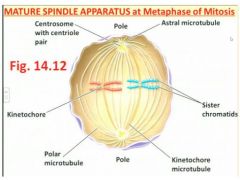
- alignment of all duplicated chromosomes occurs end to end, at the centre of the cell, along the metaphase plate that forms half-way between the poles - see Fig 14.12 including spindle apparatus
- When complete, the spindle apparatus consists of three types of microtubules (MTs): * Polar MTs that project toward, and help separate, the two poles of the dividing cell; * Kinetochore MTs that actually bind to the kinetochore protein near the chromosome`s centromere, and hence will pull the chromosome to the pole; and *Astral MTs which are small clusters that anchor the spindle`s two poles, where centrosomes (also known as MTOCs = Microtubule-Organizing Centres) are located |
|
|
Metaphase of mitosis prof's drawing on the board?
|
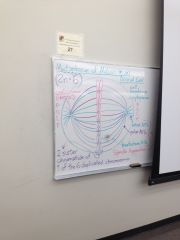
|
|
|
Mitosis - Metaphase?
|
1) Polar MTs that project toward, and help separate, the two poles of the dividing cell;
2) Kinetochore MTs that actually bind to the kinetochore protein near the chromosome's centromere, and hence will pull the chromosome to the pole; and 3) Astral MTs which are small clusters that anchor the spindle's two poles, where centrosomes (also known as MTOCs = Microtubule-Organizing Centres) are located |
|
|
Mitosis - Anaphase?
|
centromeres of each duplicated chromosome separate, as individual chromosomes are pulled along kinetochore MTs of the spindle, to opposite poles of the mother cell which become even more distant, by pushing and lengthening of the polar MTs "make a V shape"
|
|
|
Final cell cycle chart?
|
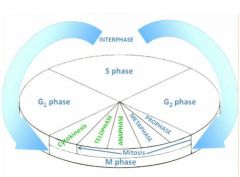
|
|
|
Telophase?
|
chromosomes reach the poles, as the nuclear envelope reforms around each chromosomes complement (also nucleolus) - Chromosomes start to decondense and uncoil, binding with protein to become chromatin again, as mitosis ends
|
|
|
Cytokinesis?
|
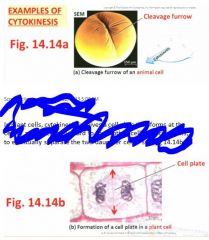
occurs immediately as mitosis is completed, with the portioning of the mother cell's cytoplasm into the daughter cellsIn animal cells, cytokinesis occurs via a cleavage furrow that pinches inwawrd between the two nuclei, to form two daughter cells
"Usually done quite equally so that the two are quite identical" In plant cells, cytokinesis involves a cell plate that forms at the centre and extends outward to the mother cell's existing walls, to eventually separate the two daughter cells "In here we can find all manner of golgi forming vesicles that are single membrane bound organelles that become part of the new cell membrane" |
|
|
Review of cell cycle in an animal cell?1
|

|
|
|
Review of cell cycle in an animal cell?2
|
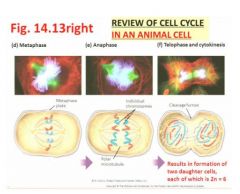
|
|
|
Prometaphase is...?
|
nbetween like Brunch is between breakfast and lunch.
|
|
|
review of mitosis?
|
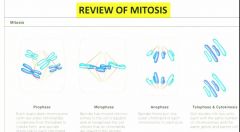
On the right (telophase & cytokinesis): Two identical body (somatic) cells are the result of mitosis and cytokinesis
|
|
|
Why produce sexually?
|
- Remember that mitosis keeps yielding daughter cells identical to the mother cell - but if the environmental conditions change such that the species can no longer adapt, production of clones via asexual reproduction can even become a liability for the species
- Perhaps is the reason why many eukaryotic species can produce botgh asexually and sexuall (eg, strawberry - runners, vs. flowers/fruits) If you can get away with aesexual reproduction, then you don't have to go thru the costs of producing powers and hoping for pollinators to move pollen around |
|
|
Meiosis translates to
|
Meiosis translates to "to make smaller", in reference to the formation of four small sex cells (=gametes) from the mother cell
|
|
|
gametes participate in
|
gametes participate in sexual reproduction (rather than asexual reproduction, like mitosis can)
|
|
|
Meiosis represents
|
Meiosis represents an extremely important process because it leads to genetic differences in the gametes (whether egg cells or sperm cells) resulting in variation within a species
|
|
|
Each mature gamete has
|
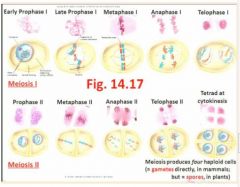
- Each mature gamete has only 1 set of chromosomes (ie, there is no homologue of each chromosome present), so this condition in the gamete is called "haploid" - see Fig 14.17 for synopsis of Meiosis I & II
"You don't have a red and a blue one." |
|
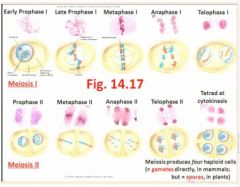
|
"Each gamete is 1n (haploid)
In meiosis metaphase 1 the homologues find each other, and then line up, two red sister chromatids and then two blue sister chromatids of the homologous chromosomes, so you never see 4 in mitosis." |
|
|
When these sex cells unite (egg with sperm) at fertilization,
|
- When these sex cells unite (egg with sperm) at fertilization, they combine their variability inot a single "diploid" cell, the zygote, which produces a uniqu individual while restoring the diploid condition of having 2 sets of chromosomes per cell
|
|
|
After many mitotic divisions, it leads to
|
- After many mitotic divisions, it leads to a new individual similar (but not identical) to either of the parents
|
|
|
Probably an indication of the value of their gametes,
|
- Probably an indication of the value of their gametes, organisms surround and protect their products of meiosis, while also having various mechanisms to allow mature gametes to be delivered or escape eg.g., animals - form gametes directly, without delay, inside the ovaries of the female (i.e., egg cells = ova) or testes of the male (i.e., sperm)
|
|
|
examples of meiosis?
|
- e.g., flowering plant - egg cell located within an ovule, where sperm cells are enclosed and protected inside a pollen grain (which is a spore)
e.g., fern plant - has an alternation of generations, between a diploid sporophyte (which forms spores by meiosis) and then a haploid, heart-shaped gametophyte that grows from the spore, and after some delay, eventually forms an egg cell at the base of each archegonium and many sperm inside each antheridium - |
|
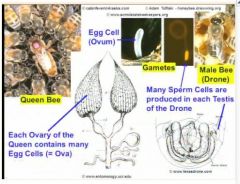
|
" Queen's abdomen is large because of the ovary sex organs and she is in control as to whether she releases sperm that she's stored in her body to cause fertilization of that egg. Workers are sterile.
" |
|
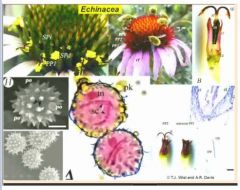
|
"Pollinated by a lot of flies and bees. Pollen grain gives protection to sperm cells located inside. "
|
|
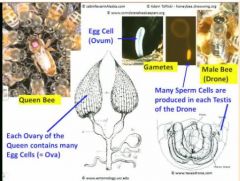
|
Production of sperm cell is in testes (male gametes and the egg being the female gamete sometimes called egg). Almost all of the Queen's cells are diploid. Meiosis is the production of sex cells.
|
|
|
To yield four products (ie gametes; spores) of meiosis, the entire phenomenon is designated into two processes simply called...
|
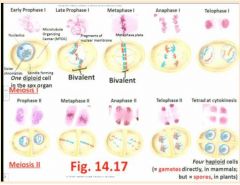
Meiosis I (followed by cytokinesis) and Meiosis II (again followed by cytokinesis)
- Each process features distinct phases, and the same prefixes introduced during Mitosis, are used again: pro-, meta-, and- and telophase; for instance, meiosis has phases called anaphase I and anaphase II "Homologues find each other. We want four variable products. Bivalent is when ?chromosomes? find each other in fours. At S, the chromatid doubles so both chromatids must be identical (two big As are homozygous dominant and two small As are heterozygous. In meiosis II, the cell wall is 90 degrees to the previous. In humans we have 23 pairs. Completely random whether you have a red one or whether you have a blue one on the right or the left in metaphase but it has a huge impact on what kind of gamete is formed" |
|
|
Very importantly, a critical difference between Mitosis and Meiosis I is that late in prophase I of meiosis...
|
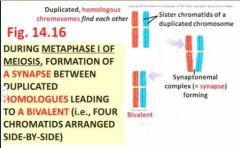
late in prophase I of meiosis, each duplicated chromosome (ie containing sister chromatids) is drawn to its homologous chromosome ( a synaptonemal) complex = synapse forms), which causes the homologues to align side-by-side (rather than aligning end-by-end as occurs in the metaphase plate of Mitosis) - alignment (left or right) occurs randomly!
Thus, in metaphase I of meiosis, find the arrangement of bivalents (=the duplicated homologous chromosomes are tightly held side-by-side to one another), so that in each bivalent there are actually 4 chromatids across - see Fig 14.16 |
|
|
Another very important event that also happens randomly and leads to increased variation, is the formation of a chiasma (a cross- over) between...
|

between adjacent, non-sister chromatids of the bivalent
|
|
|
Chiasma allow
|
- "allows exchange of DNA between chromatids"
- "chiasmas are a completely random event" Thus, the alignment of duplicated chromosomes at random within the homologous pair, plus the random formation of cross-overs (chiasmata) at a random site along the non-sister chromatids of the bivalent, leads to incredible possibilities for variation within the four haploid products of meiosis, especially when the diploid (2n) number of chromosomes is high! (ie, in humans, 2n=46) - the stage is set for causing variation, here in metaphase I of meiosis - |
|
|
Notice that by the end of Meiosis I (ie, following completion of anaphase I, telophase I, and cytokinesis), the 2 cells produced are already reduced to the...
|
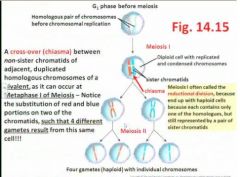
to the haploid state; that is, although each cell still contains a duplicated chromosome with sister chromatids, the homologue is no longer there (because it has moved to the other cell!), so there is only one set of each chromosome per cell; thus, Meiosis I is often referred to as the reductional division of the entire process of meiosis
|
|
|
Note that Meiosis II shares similarities with Mitosis, in that the duplicated chromosomes at metaphase II now align end-by-end and, by anaphase II, centromeres have separated so that sister chromatids now get delivered by kinetochore microtubules of the spindle apparatus, to the separate poles; thus four diff _____ cells are produced
|
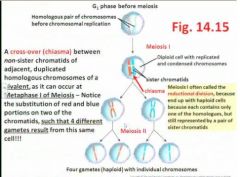
haploid
|
|
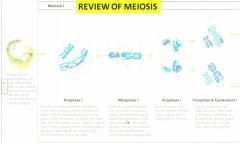
"Different lengths are not the same homologues"
|

"Different lengths are not the same homologues"
|
|
|
Each one of the four products of meiosis (ie gametes in animals; spores in plants, fungi) are typically much diff (based on
|
based on the alleles of their chromosomes' genes) from the other three, owing to chromosome alignment and chiasmata formed at metaphase I- ie, they end up with a diff genetic make-up - hence, variation from the parent has been achieved, leading to a unique, brand new individual once fertilization (involving another parent) has occurred!
|
|
|
diff orgs vary greatly in terms of their size (and hence
|
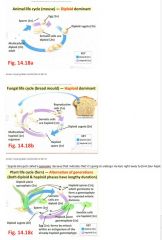
and hence how many mitotic divisions have occurred to build up their number of somatic (body) cells), plus the duration of the diploid and haploid stages in their life cycles, and where and when meiosis occurs
|
|
|
Comparison of Life Cycles?
|

"Pollen are spores and they're highly reduced spores. Inside them they undergo a mitotic division to produce two sperm cells and these sperms are needed for double fertilization which is beyond our course"
|
|
|
Classical genetics?
|
transmission of hereditary info
|
|
|
molecular genetics?
|
mechanisms related to transmission and use of genetic info, and genetic mutation
|
|
|
Bioenergetics?
|
how energy is harvested from sunlight, and how it is used by plants and animals?
|
|
|
Applications of classical and molecular genetics to can be summarized as...
|
bio tech and experimental techniques
|
|
|
learning outcomes for this section: (genetics moll biology, applications)
|
learning outcomes for this section: (genetics moll biology, applications)
|
|
|
classical genetics?
|
the basis by which traits are inherited and teh major patterns of inheritance
|
|
|
moll genetics?
|
mechanisms related to transmission and use of genetics info, related to gene transcription and gen product translation
|
|
|
classical genetics are the encapsulation...
|
of this course.
|
|
|
Mol genetics has two main...
|
processes: gene transcription (the info that is encoded in DNA sequences is transcribed into RNA prior to use) and gen product translation (gene products being translated from nucleic acids into proteins). You should be aware that proteins are the user information of the cell for genetic sequences.
|
|
|
molls are held toegether by...
|
chem bonds; all sorts of chem bonds in particular strong bonds that are covalent, weaker bonds that are ionic and hydrogen bonds
|
|
|
The major molls that form the bulk of the structure of cells are...
|
polymers which are polymerized from relatively few monomers.
|
|
|
In this part of the course, the polymers we'll be most interested in are _____________ and the monomers are......
|
nucleic acids
and the monomers are nucleotide bases |
|
|
_________________ are for biochemical specialization within the cell
|
eukaryotic
|
|
|
Although proks are strucurally ___________, they are extremely _________________ biochemically and we depend on proks and contend with them in all of our daily lives
|
structuralliy simple
sophisticated biochemically |
|
|
Plant cell wall gives structure which is supported by internal _______________ pressure
|
hydrostatic
|
|
|
_________ are ___________________ organelles which were originally derived from the chloroplast. They share ___________.
|
plastids
endosymbiotic Mitochondria. and nucleus. |
|
|
What are the three kinds of genetics?
|
transmission genetics
molecular genetics population genetics |
|
|
transmission genetics?
|
inheritance of traits
|
|
|
molecular genetics?
|
genes to phenotypes
|
|
|
population genetics?
|
allele frequency related to natural selection, drift, mutation, flow between populations
|
|
|
what kind of genetics will we focus on?
|
transmission genetics
|
|
|
Traits that are inheritable are...
|
ones from your parents that'll go to your offspring. Other traits include ones that you'll get from nurture rather than nature, but this has to do with inborn or intrinsic features
|
|
|
Pheonotype is...
|
the sum of all the characteristics createed by your protein coding genes and by the relationship between these genes durin org development
|
|
|
What kind of genetics will we not talk about at all in this course?
|
population genetics
|
|
|
Hippocrates?
|
inherit acquire characteristics from your parents
|
|
|
Aristotle?
|
In herit the potential to form the same features as your parents
|
|
|
Early 19th century?
|
characteristics of the parents were blended in the offspring
- populations would be expected to become more similar over generations - difficult to reconcile with the sudden appearance of new traits |
|
|
It was originally thought that you inherited acquired characteristics...
|
from your parents
- eventually realized that you inherited the potential |
|
|
By th 1500s 1600s, horticulturalists had already...
|
created a variety of orgs with distinctive traits
|
|
|
from the 1950s Dmitri Belayev took...
|
2 groups of foxes, bred them together and in each succeeding gen, he selected the most friendly and the least friendly and bred them to themselves and over 8 generations these wild animals have become very much more like dogs (their vocalizations, they actions, in another 3 gens they have droopy ears, diff coats like dogs) other population selected for lack of friendliness had become more like that. The point here is that selection takes very few generations. So selection for crop plants, for crop animals can be repeatedly generated in a relatively short period of time that depends mostly on the generation time of the organism in question.
|
|
|
Who were the first geneticists?
|
Farmers were the first geneticists
- selected and propagated animal and plant strains with desirable traits |
|
|
Nowadays the grains that we eat are extremely...
|
large compared to the wild seeds. Most grains weigh at least 50mg.
|
|
|
We have been able to create domesticated animals of anumber okinds but
|
but not of others. Cattle, pigs, sheep, chickens have been domesticated in a number of ways because they have become metabolically attuned to living w people. Deer zebras and bison can be herded by they can't be domesticated.
|
|
|
The blending idea is a good predictor for...
|
mutli-gene characteristics but not a good predictor for single gene characteristics and until someone came along and was able to investigate single gene specified traits we couldn't get any further and that person was Gregor Mendel.
|
|
|
Gregor Mendel was trained to be...
|
a science teacher (studied mathematics, practical and theoretical subjects) but failed to qualify, so returned to his abbey to farm.
|
|
|
Gregor Mendel was not allowed to?
|
Study of inheritance of animal characteristics (mice) was not permitted by his abbot. Chose peas.
|
|
|
In the 1850s while Mendel did his work,
|
- relatively little was known about cell theory
- nothing was known about nuclei - microscopes were not generally available |
|
|
In Mendel's experiments....
|
- several pairs of true-breeding pea strains (these would have been created by previous generations of farmers)
- grew these strains for three seasons to confirm - the traits he studied were controlled by single genes that had two distinctive alleles "He had strains where all were purple and all were white There were also differences in flower position Fortunately for him and fortunately for us, it turns out that the traits he was studying were controlled by single genes and the genes had distinctive alleles and the alleles are the characteristic of an individual variant of a gene that controls some aspect of its phenotype and so here we have a gene for colour and it has an allele that's white and it has an allele that's purple. One for position and one for terminal." |
|
|
How did Mendel reproduce the plants?
|
he could dissect the flower and either keep the stamens(male part) which contain one of the gametes or stigma(female part) and he could dissect his plants before fertilization and control where the pollen came from.
|
|
|
How long did Mendel's experiments take?
|
several months
|
|
|
Mendel's results could not be explained by...
|
a blending of parental characteristics or tendencies, or else you would have slightly wrinkled seeds
|
|
|
particulate inheritance?
|
discrete "particles" of genetic information are inherited from each parent and one particle will be dominant over the other (Mendel's hypothesis)
|
|
|
How many true-breeding traits did Mendel test?
|
seven true-breeding traits
|
|
|
for classical transmission genetics, testing a dominant-phenotype individual's genotype involves...
|
mating
|
|
|
Mendel's term for gene?
|
discrete particles
|
|
|
Genotype?
|
genetic make up of an organism?
|
|
|
Traits we see?
|
Phenotype?
|
|
|
Gene?
|
A unit of hereditary information?
|
|
|
Allele?
|
A version of a gene?
|
|
|
Homozygous?
|
When both alleles of a given gene are identica (only in diploid orgs)?
|
|
|
Heterozygous?
|
When two alleles for a given gene differ in an individual?
|
|
|
Phenotype is the result of...
|
the interplay of all the genetic characteristics as they play out in the final org.
|
|
|
Allele is the version of a gene that...
|
that you can see
|
|
|
Mendel looked at
|
- flower color
-flower position -seed color -seed shape -pod color -pod shape -plant height when he crossed the true breeding lines |
|
|
Genes are heritable
|
heritable particles
|
|
|
Gene variants are
|
alleles
|
|
|
Mendel focused on how many genes at a time?
|
One gene
|
|
|
Mendel`s 1st law?
|
Alleles of one gene segregate independently from one another during the formation of gametes.
|
|
|
Monohybrid Cross?
|
a cross involving one gene
eg. the gene for plant height |
|
|
You'll only get the 3:1 ratio thing if ...
|
if according to Mendel's first law, alleles of a single gene segregate independently during gamete formation
|
|
|
For this model to be true, the individual must have ______ copies of each gee and the gametes must have only _____ copy
|
two copies
one copy ---> law of segregation of alleles |
|
|
For one gene you need how many alleles?
|
two. one from mother and one from father
|
|
|
If two alleles are different, one will be
|
dominant
|
|
|
"gene" was coined by
|
Wilhelm Johannson, 1911
|
|
|
Each sperm or egg cell carries...
|
only one alele of a given trait because they segregate from one another
|
|
|
Alleles are represented by
|
single letters
|
|
|
True breeding plants are
|
homozygous
|
|
|
Genetic make up of an org?
|
Genotype?
|
|
|
Traits we see?
|
Phenotype?
|
|
|
Gene?
|
A unit of Hereditary information?
|
|
|
Allele?
|
A version of a gene and they are indicated by letter symbols?
|
|
|
Diploid orgs can be?
|
homozygous or heterozygous
|
|
|
homozygous?
|
When both alleles of a given gene are identical?
|
|
|
Heterozygous?
|
when two alleles for a given gene differ in an individual?
Aa (one gene) BbQq (two genes) |
|
|
The punnet square was invented by?
|
Reginald Punnet
|
|
|
Reginald Punnet's first book was?
|
in 1905
|
|
|
Results Mendel got in his dihybrid crosses of pea plants revealed...
|
another important principle of inheritance now referred to as Mendel's second law of inheritance
|
|
|
Mendel's 2nd law?
|
Alles of diff genes assort independently of one another during gamete formation
|
|
|
Aspergillus and most fungi are vegetatively ...
|
haploid, there is one diploid nucleus
|
|
|
certain results are only possible because the two alleles segregate...
|
independently from each other
|
|
|
Probability and genetic analysis?
|
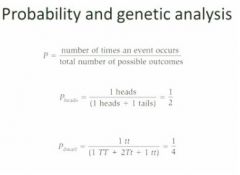
|
|
|
Tri-hybrid crosses?
|
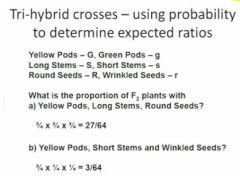
|
|
|
True-breeding is _______________ in nature
|
unusual
|
|
|
Individuals have _____ copies of each gene
Gametes have _________ copy |
two
one |
|
|
segregation in modern terms?
|
Alleles separate into diff haploid cells that eventually give rise to gametes. Then during fertilization, male and female gametes randomly combine with each other.
|
|
|
Monogene inheritance and digene inheritance are a matter of...
|
are a matter of interpretation ... how many things we're interpreting in the cross
|
|
|
Incomplete dominance?
|
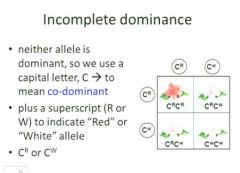
You see the heterozygotes immediately. You don't have to do another breeding to see the heterozygotes.
Incomplete dominance permits direct observation of heterozygosity, unlike peas. |
|
|
Many genes have multiple alleles (more than two)
Sometimes these alleles are expressed together |
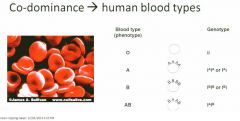
|
|
|
In the human blood type phenotype, red blood cells have a _____ _____________ on the surface and it can either be elaborated in the A type with
|
basic backbone
in the A type with a small sugar molecule called the N-acetylgalactosamine, In B type it’s the galactose , in the AB you an have both kinds and in the O you have neither |
|
|
These diff phenotypes are not required for the function but are involved in the...
|
in the interaction between blood cell types and if you have a transfusion where you are transfusing blood that contains an antigen type that your body is not accustomed to then the recipient for that transfusion will mount an immune response against it because the transfused blood is being recognized as foreign and you get a clotting of the transfused blood which leads to death.
|
|
|
In diff racial groups you have diff ...
|
- In diff racial groups you have diff proportions of people who have diff kinds of antigens. Original Africans have all four kinds. Native Americans only have two.
|
|
|
1939v new problem with transfusions arose.
|
People with right ABO match still had problems. Rhesus macaque - kind of monkey blood
90% have the Rh factor 10% do not. So we now have a nuanced understanding of this blood type cross matching. |
|
|
Universal donors are the
|
O-
|
|
|
Universal recipients are the
|
AB+
|
|
|
Can't have O and A parents resulting in
|
- Can't have O and A parents resulting in AB - now we have more complicated paternity tests but they all stem from Mendellian genetics
|
|
|
___________________ _______________ are more likely to share these factors than unrelated donors
|
family members
|
|
|
Blood matching is less complicated than?
|
Tissue matching is more complicated than?
|
|
|
Genes can lead to predisposition to...?
|
Genes can lead to predisposition to habit
|
|
|
Some diseases 'run in families'. Is this
|
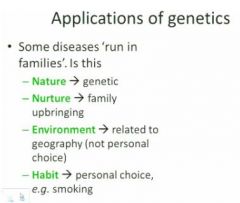
|
|
|
family trees are also called
|
pedigree analysis
|
|
|
pedigree analysis is used
|
used to determine if a disorder may be related to heredity
|
|
|
many _______________ respond to environmental factors
|
phenotypes
enviro factors such as temperature |
|
|
Although you can examine the effect of a single gene, you're always doing it in the context of
|
the entire organism.
|
|
|
Some traits are controlled by multiple genes
|
What traits were the basis for blending inheritance models in the 1800s?
|
|
|
Done more experiments with _______ than any other species.?
|
dogs?
|
|
|
How many genes control the hairiness of dogs?
|
Three.
Hair length, consistency, and curl. There are alleles for each of these. eight other genes govern color |
|
|
Can one gene affect many traits?
|
Yes. Genetic pleiotropy.
|
|
|
Who first noticed genetic pleiotropy? And what did thye notice?
|
Mendel noticed
- plants with coloured seed coats had coloured leaf axils - plants with colourless seed coats had non-pigmented axils |
|
|
What is an animal example of genetic pleiotropy?
|
About 40% of blue-eyed white cats are deaf
- this is associated with degeneration of the cochlea (inner ear) - Some odd-eyed cats are deaf on the blue side |
|
|
In humans, there are ____ pairs of autosomes and ________ pair of sex chormosomes
|
22
1 |
|
|
In humans, women are
|
XX
|
|
|
In hhumans, men are
|
XY
|
|
|
Autosomes are
|
chroms that affect only general body characteristics
|
|
|
Sex chroms determine
|
determine the gender of the individual
|
|
|
The sizes of the X and Y?
|
They Y chrom, although it is very small has some extremely important sexual determining characteristics whereas the X is very large and encodes a large number of autosomal traits as well as the sex trait.
The Y chrom although is small and has relatively few protein encoding genes, many of these turn out to be transcription factors that are turning on sexual characteristics in the developing fetus. If you lack Y, then you are female, if Y is overlaid on the X then you are male. |
|
|
We know the most about genetics in chickens because..
|
we like to eat chickens and that's often how it works
|
|
|
Genetics in birds?
|
ZW females
ZZ males best studied in chickens |
|
|
genetics in bees
|
XX FEMALES
XO MALES unfertilized female bees can only produce males Johann Dzierzon, a Catholic priest 1845 discovered long before Mendel |
|
|
Reptile genetics?
|
30 C -> females
30-34 C -> both sexes 34 C -> males could become an issue as climate change transpires |
|
|
Depending on the gene and the species, alleles can show
|
- complete dominance (Mendel's peas)
- incomplete dominance (flower colour in 4-o'clocks) - co-dominance (human blood type) |
|
|
short definition of pleiotropy?
|
One gene, multiple phenotype responses.
|
|
|
The Y-chromosome has only
|
has only a few genes (about the size of chromosome 22)
|
|
|
If a human male has a defective allele on his X chromosome
|
no backup copy on Y
|
|
|
red-green colour blindness is most
|
is most common sex-linked problem
|
|
|
If you are XX
|
then you're female and one is active and one is not
|
|
|
if you are male and you have XY and if there's a problem on X
|
there's no backup copy of those genes on Y and so if you have a defect in the X chrom, then you wind up being female (I think)
|
|
|
Colour blindness is is found in ______ % of men
but only in ____ % of women |
5-10
0.5-1 |
|
|
Why the difference between genders?
|
If you are a color blind male, all you have to have is they y chrom from your father and the color blind X from your mother so you're color blind for x and normal for y. Women have colour blind father and a mother that has one copy of a color blind X gene. Rare for women.
|
|
|
Potential adaptive advantages?
|
Peopple that are colour blind have better grey scale perception.
|
|
|
Pedigree analysis is for...?
|
organisms where gender is determined by chromosome
|
|
|
What are the implications of pedigree analysis?
|
This means that not only can genetic diseases run in families but in addition they have a sex linked preponderance.
You don't see hemophiliac women, you do see hemophiliac men. |
|
|
In an autosomal linkage you can have either
|
gender being a carrier because each chrom is represented twice in both genders. Here you can have transmission of a trait but the trait is not gender specific.
|
|
|
If there are are relatively few individual represented, then these are
|
recessive traits and that means that in order to show the phenotype you need to have both copies, in this case this is very much like flower color inheritance in peas for example where if you have one copy of the dominant gene you show the purple color phenotype but you need two copies of hte recessive to showt he sam phenotype.
|
|
|
Sex linkage was first determined to be a genetics phenomenon back in
|
1910 shortly after the rediscovery of Mendel's ideas. This has been very extensively studied since that time originally in Morgan's lab where he was studying Drosophila
|
|
|
Why did Morgan study Drosophila?
|
because rather than people, drosophila has a very short generation time (flies). Like us the female is XX and the male is XY
|
|
|
What did Morgan find wtih his flies?
|
After two years of studying these things and trying to understand how the phens were inherited, a fly was isolated that had white eyes rather than the usual red eyes. These flies also happened to be blind and this turns out that pigment and eye perception were linked. this fly happened to be male.
In the F1 generation, there were no white eyed flies and this is what you'd expect because the wild type female having not come from a mutant population would be expected to have both wild type X. But in the F2 gen.... This suggested that the defect was on the X chrom |
|
|
Crappy notes on Morgan's Drosophila?
|
- Morgan used fruit flies to demonstrate the chromosomal basis of inheritance of sex-linked traits
- In fruit flies, female is XX, male is XY - In the f2 generation, all the white-eyed flies were male - The gene that was affected was located on the X chromosome and can be followed through various other crosses. |
|
|
If you have a sex linked trait, when you mate a mutant with a wild type,
|
If you have a sex linked trait, then when you mate a mutant with a wild type, the characteristic disappears in the f1 gen and when you mate the f1 gen to itself, it reappears but you only see it in the gender which is considered to be hemizygous for that trait
|
|
|
linkage between autosomal traits?
|
We've talked about sex linkage and now we can talk about linkage between autosomal traits. When Mendel was doing hist studies on peas, each of the characteristics he was mating had no apparent relationship to any other traits but taht isn't always the case. There are going to be cases where if you look at a parental inheritance, you will see the standard 3:1 pattern, but if you look at the pattern pairwise, you see a very different kind of inheritance relationship. So we don't see this in single genes but we do see it when we look at pairs of genes. You don't get the same expected phenotype.
|
|
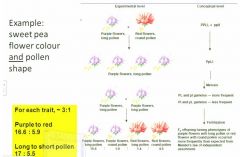
Was Mendel wrong? Does it work in peas but not in sweet peas?
|
It's that there's more than one locus on each chrom and loci that are close together tend to be inherited together. For purple to red, you have 18:6 which is good and for Long to short pollen you have about 18:6 which is good but for the pairwise inheritance we don't see that pattern.
|
|
|
Gene linkages being inherited together?
|
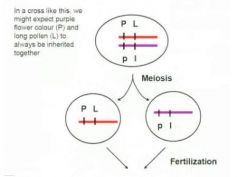
|
|
|
Only have to worry about linkage when you're talkng about...?
|
dihybrids
|
|
|
That divergence from expected and observed phenotype ratios indicates recombinants was first discovered in...?
|
Morgan's lab
|
|
|
Crossing-over in meiosis I increases
|
genetic variability by recombining parental allele assortment for loci on the same chromosome
|
|
|
Linkage can be used for mapping
|
distances between loci
|
|
|
Crossover frequency is related to
|
physical distance between loci
|
|
|
Genetic distances are
|
% recombination, measured in centiMorgans
|
|
|
map distance =
|
(number of recomb offspring/total number of offspring) x 100
|
|
|
They can organize loci on a chrom by looking at the
|
inheritance of parental traits vs the inheritance of recombinant traits.
Mutant flies are mated with wild flies and then you look at the paralyzed inheritance of the two traits and in doing this we've been able to order diff genetic loci down a chrom. |
|
|
Linkage is when
|
you have two traits where the parental combinations are more preferrentially inherited than the recombinants.
|
|
|
If you have unlinked genes, you will have situations where you have the function of one gene depending on
|
depending on the function of another gene (previous gene), so you have a series of genes in a biochemical pathway. The function of downstream members of the pathway is going to depend on members of the upstream. The white phenotype can't make pigment and there' s two step process where there's yellow and then the fully formed pigment is green so what happens here is that if you have a parent who has a white spore then that will be inherited 50% of the time and if you in herit that then it doesn't matter what you have at the other genetic locus, you will be white. Approx. 50% of the matings for a strain where one of the parents is white must be white because it's unable to make any kind of pigment no matter what the other locus encodes.
|
|
|
Epistasis is?
|
When inheritance of a trait is dependent on more than one allele.
- the inheritance of an allele at one locus affects the phenotypic expression of an allele at a second locus - spore colour in aspergillus |
|
|
Epigenetics?
|
- Mitotically or meiotically heritable changes in gene function, that are not related to DNA sequence
Epigenetics has been considered as a relatively recent kind of genetic mechanism but it is becoming more and more relevant and more and more important for biotech and for understanding of disease. |
|
|
Environmental gene regulation
- prenatal environment -> nutrient supply, stress ? |
One of the first places this was identified was a the end of WWII in NW Netherlands. During the war there was an imposed famine on part of the Netherlands, calorie intakes were dramatically reduced so ther ewas a whole cohort from September to April just 6 months where calorie intakes were cut by up to 2/3rds so the question that was asked following the resolution of the second wordl war was What happened to the children who were devleoping in eutero during that time? These children have been followed since and these children who were stressed in eutero have developed many kinds of phenotypic disease relationships particularly enhanced diabetes and enhanced heart disease compared to the populations who were born immediately before the famine
Post WWII Netherlands study Suggests that there are relationships between the genes and the cellular enviro that the genes are operating in which means what we had originally imagined that genes were the master orchestrators of protein production, but actually the genes are responses to the cellular context that they're operating in. 2 major ways that we're understanding the way that these effects are generated. |
|
|
Mechanisms
- chromatin modeling and histone modification - dna methylation patterns |
During chrom condensation of mitosis and meiosis, the DNA is never entirely exposed. It's wound around proteins called pit stones and it is modification of the pit stones that relates to the relative affinity of the histone 40 DNA double helix and the reason this is important is that because it's never exposed, the tightness between the histone and the DNA is going to relate to the transcription rate so the ability for a gene to be able to transcode a protein is related at a fundamental level to its exposure to the biosynthetic complexes that are going to generate it.
The other way is through methylation of cytosene on the DNA. When an area of DNA is methylated then it tends to be less highly transcribed and less highly translated so again you can have long term changes in the methylation of a gene that will change the relative transcription and relative translation of the genes that are in herited regardless of the alleles that are in that gene. This is an extra level of regulation which we now know is also going to be important. |
|
|
DNA-histone association affects
|
gene activity, not DNA sequence
|

